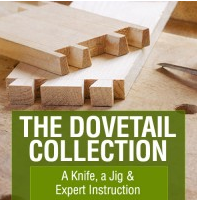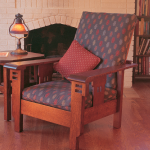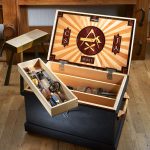We may receive a commission when you use our affiliate links. However, this does not impact our recommendations.
 After workbenches and finishing, the questions we get asked most often are about hand-cut dovetails. So, we’ve put together a kit that includes the Woodjoy Precision Dovetail Template (the brass and black oxide one you’ve perhaps seen me use in the magazine and on the blog), an inexpensive but excellent marking knife from Lee Valley, Rob Cosman’s step-by step guide to dovetails, Ian Kirby’s book “The Complete Dovetail,” a Roy Underhill’s video on making half-blind dovetailed drawers and Glen Huey’s “Cheating at Hand-cut Dovetails” video. In other words, it’s everything you need to make hand-cut dovetails except the saw and the wood. You’ll find that kit, “The Dovetail Collection: A Knife, a Jig & Expert Instruction” in our store now, for $80 (but in a limited quantity, so I recommend ordering right away if you’re interested).
After workbenches and finishing, the questions we get asked most often are about hand-cut dovetails. So, we’ve put together a kit that includes the Woodjoy Precision Dovetail Template (the brass and black oxide one you’ve perhaps seen me use in the magazine and on the blog), an inexpensive but excellent marking knife from Lee Valley, Rob Cosman’s step-by step guide to dovetails, Ian Kirby’s book “The Complete Dovetail,” a Roy Underhill’s video on making half-blind dovetailed drawers and Glen Huey’s “Cheating at Hand-cut Dovetails” video. In other words, it’s everything you need to make hand-cut dovetails except the saw and the wood. You’ll find that kit, “The Dovetail Collection: A Knife, a Jig & Expert Instruction” in our store now, for $80 (but in a limited quantity, so I recommend ordering right away if you’re interested).
Really, the best things I learned about cutting dovetails (after learning to cut straight down on a line) is to do one corner joint every day for a month – somewhere in the neighborhood of three to four tails and matching pins. I spent my lunch breaks for a month 10 years ago doing this – and by the second week, I still had time to eat. Christopher Schwarz wrote about this “Dovetail a Day” approach in Woodworking Magazine; it’s free on our site here.
By the end of the month (likely well before it), you’ll be cutting perfectly acceptable joints. The key is to assess your progress each day, try to evaluate when went wrong where, and concentrate the next day on addressing those problems.
But I think it’s also important to realize that while “perfect” dovetails may be worth striving to achieve, joints that you might consider ugly will likely stay together just fine. (Don’t believe me? Take a look at Mark Firley’s blog “The Furniture Record” for lots of less-than-perfect examples of vintage joints that are still holding strong. Or just visit a local antiques store and start taking a close look at some 19th-century drawers.)
I know, however, that “light-tight” dovetails are the goal of many makers. That is, we strive for joints that serve as decoration and a testament to skill, as well as hold pieces of wood together.
So, here are some “fixes” for baseline errors. Next week, I’ll post some fixes for splay errors and other “mistakes.”
Baseline Errors Fixes:
1. Try to clamp it out. Put blocks on the tails, squirt a runny glue in there (such as white glue or West System epoxy) then clamp the snot out of it to try to pull the tails down a little and make them stick.
2. Bishoping (if tails/pins are proud). Wet the tail/pin, then tap gently with ball-peen hammer to mushroom it a little. (Don’t peen below carcase surface.) This is most effective in softer woods (and can also be used to fix minor splay gaps).
3. Controlled spelching. That is, plane toward the unsupported gap in such a way as to purposely direct tear-out into the gap (this works only for small gaps, and the key word is “controlled”).
4. White glue & sandpaper. If it’s a drawer side or other joint that won’t see a finish (other than paint), you can squeeze some glue in the gap and sand over it; the dust will mix with and color the glue, thus hiding the gap.
5. Shim. For big gaps, cut some shims (try to match to color and grain direction) and glue them in. Once they’re dry, flush-cut the shim to the piece side. shims.
6. Fill with Durham’s Water Putty, then paint.
7. Live with it; the piece will (likely) stay together.
And remember:
• “Cabinetmakers have been hiding dovetail mistakes from rich people for centuries.” (The guy who taught Christopher Schwarz to cut dovetails)
• “Everyone who has ever cut a dovetail has &*%^ed up a dovetail.” (Me and everyone else who’s ever talked about this joint)
Here are some supplies and tools we find essential in our everyday work around the shop. We may receive a commission from sales referred by our links; however, we have carefully selected these products for their usefulness and quality.









